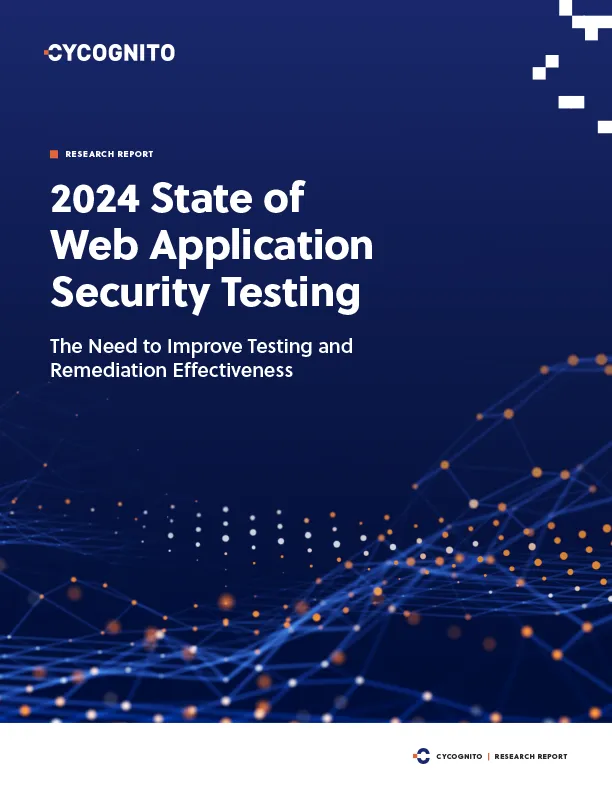What Is Security Testing?
Security testing is the process of identifying and validating vulnerabilities and weaknesses across applications, systems, and networks to prevent cyber threats such as breaches and data loss. The process involves evaluating the security mechanisms of a system to ensure it can protect data and functionality from unauthorized access and malicious attacks.
Successful security testing depends on accurately simulating the techniques attackers might use to exploit vulnerabilities. To achieve this, security teams systematically test for weaknesses in authentication, authorization, data handling, and other critical components. The process typically combines automated tools with manual techniques to recreate real-world attack scenarios and assess how well systems withstand them.
This is part of a series of articles about application security.
Why Is Security Testing Important
Security testing aids in protecting business operations and user data. It identifies risks before they become incidents, giving organizations the chance to address issues proactively rather than reacting after damage has been done. This approach strengthens defenses, reduces downtime, and ensures compliance with required standards.
- Protects sensitive data from cyber attacks: Validates that controls around confidential and regulated information work as intended, preventing exposure to unauthorized parties. This is critical for data such as financial records, personal information, intellectual property, and trade secrets.
- Prevents security breaches: Finds and addresses system weaknesses that attackers could exploit. This includes misconfigurations, outdated components, and logic flaws that might allow bypassing security measures.
- Maintains user trust: Demonstrates to customers, partners, and regulators that security is taken seriously. Consistent testing reassures stakeholders that the organization is committed to protecting their information.
- Avoids legal and financial consequences: By identifying and fixing security gaps, organizations reduce the risk of costly breaches, data loss, and associated penalties. Non-compliance with security regulations can result in fines, litigation, and mandatory breach disclosures. Proactive testing mitigates these liabilities.
- Ensures business continuity: Security incidents can disrupt operations by taking systems offline or corrupting critical data. Testing reveals resilience weaknesses such as lack of failover systems or poor incident response mechanisms, so organizations can prepare for and recover from attacks with minimal downtime.
- Meets compliance requirements: Many sectors, including finance, healthcare, and government, require regular security testing to meet legal and industry standards. Compliance reduces the risk of penalties, legal action, and loss of operating licenses.
- Improves system reliability: Detects weaknesses that could cause instability, downtime, or crashes. By fixing these issues, systems run more reliably, supporting both security and operational goals.
9 Key Criteria to Test for in Security Testing
Security testing should cover the main areas where vulnerabilities can arise. Focusing on these criteria ensures that critical security controls are in place and effective.
- Authentication: Verify that only legitimate users can log in, using strong password rules, multi-factor authentication, and protection against brute-force attacks.
- Authorization: Ensure users have access only to permitted resources and actions, and check for privilege escalation or role-based access control flaws.
- Data protection: Confirm encryption of sensitive data in transit and at rest, secure key handling, and safe removal of data from logs, caches, and backups.
- Input validation: Test how the system handles user input to block injection attacks like SQL injection, command injection, and cross-site scripting.
- Session management: Review how sessions are created, stored, and expired to prevent hijacking, replay, or fixation attacks.
- Error handling and logging: Make sure error messages do not reveal internal details, and that logs capture useful security data without exposing sensitive information.
- Configuration management: Check for secure defaults, removal of unnecessary services, and timely patch application.
- Availability and resilience: Assess the system’s ability to withstand denial-of-service attempts, resource exhaustion, and overload without losing functionality.
- Third-party dependencies: Verify the security of APIs, libraries, and other integrated components, ensuring they are updated and trustworthy.
Main Types of Security Testing
Vulnerability Scanning
Vulnerability scanning uses automated tools to inspect systems for known security weaknesses. These scans flag outdated software versions, insecure configurations, missing patches, and misconfigured permissions. Regular scans help security teams maintain visibility over the threat landscape and prioritize remediation based on risk severity.
However, vulnerability scanning has limitations, as it primarily identifies publicly documented flaws. It does not inspect business logic or novel attack techniques that a determined attacker could exploit. As such, it functions best as a routine hygiene measure, often performed in tandem with more targeted testing like penetration tests.
Penetration Testing
Penetration testing, or pen testing, simulates real-world attacks to uncover vulnerabilities and actively exploit them in a controlled manner. Unlike vulnerability scanning, pen testing includes manual exploration by skilled testers who mimic adversary behavior to probe systems for misconfigurations, logic errors, and chained attack paths. This method often reveals complex vulnerabilities that may go undetected by automated tools.
Thorough penetration testing produces prioritized remediation guidance and a clear picture of how a breach might unfold within an IT environment. Organizations benefit by understanding the full impact of potential attacks and can refine their defenses based on concrete, demonstrated risks. Routine pen testing is critical for organizations operating in high-risk or regulated industries.
Application Security Testing
Application security testing targets software-specific vulnerabilities, ensuring custom and third-party applications withstand malicious manipulation. This process covers both front-end and back-end code, focusing on input validation, error handling, session management, and direct object references. Testing can be manual, automated, or a combination of both, depending on application complexity and risk profile.
Because applications are frequent attack targets, security testing is crucial for any business that relies on software to handle sensitive data. Adequate testing helps uncover risks introduced during development or through dependencies on third-party components. Identifying and fixing these weaknesses reduces the likelihood that vulnerabilities will reach production environments.
Network Security Testing
Network security testing evaluates how an organization’s internal and external networks are defended against unauthorized access, eavesdropping, and disruption. This testing encompasses configuration reviews, protocol analyses, vulnerability scanning, and simulations of various network-based attacks. The goal is to verify that firewalls, intrusion detection/prevention systems, and network segmentation are properly implemented.
Network security testing also examines lateral movement potential and privilege escalation within the infrastructure. By identifying and remediating weaknesses in network design or controls, organizations can substantially limit the attack surface and disrupt common tactics used by threat actors in advanced persistent threats (APTs) and ransomware campaigns.
API Security Testing
API security testing ensures that application programming interfaces—integral for modern, interconnected solutions—are properly secured. This involves validating authentication, authorization, data validation, rate limiting, and encryption practices for APIs. Testing tools search for flaws like broken object-level authorization, insecure data exposure, and injection vulnerabilities that can compromise application security.
Given APIs often handle sensitive business logic and data exchange across services, even a minor oversight in security controls can have outsized impact. Routine API testing is necessary to keep up with changes in API endpoints and evolving attack techniques. Techniques range from automated scanning to manual code review and logic analysis, depending on API criticality.
Social Engineering Testing
Social engineering testing assesses an organization’s resilience to manipulation and deception targeting human operators. Common techniques include phishing simulations, pretexting, or physical attempts to bypass security procedures and gain unauthorized access. These tests reveal gaps in employee awareness, training effectiveness, and adherence to organizational security policies.
Technology controls alone cannot prevent breaches that exploit human error. By regularly testing against social engineering attacks, organizations can pinpoint weaknesses in the human layer of defense, improve training, and refine incident response plans. This strengthens overall cybersecurity posture by reinforcing a culture of vigilance and accountability at every level.
Tips from the Expert

Dima Potekhin, CTO and Co-Founder of CyCognito, is an expert in mass-scale data analysis and security. He is an autodidact who has been coding since the age of nine and holds four patents that include processes for large content delivery networks (CDNs) and internet-scale infrastructure.
In my experience, here are tips that can help you better optimize and elevate your security testing program beyond common best practices:
- Correlate security testing gaps with adversary simulation results: Don’t treat testing outputs in isolation. Correlate findings from red team or breach-and-attack simulations with areas your security testing didn’t flag. This highlights blind spots in tooling or test coverage and reveals real-world exploit paths your testing missed entirely.
- Continuously assess and test security controls under failure conditions: Include scenarios where security tools are disabled, misconfigured, or operating under degraded conditions (e.g., expired certs, overloaded WAFs). Testing under “broken defense” conditions shows whether layered protections actually provide redundancy or if a single failure opens the door to compromise.
- Use threat modeling to define security testing scope—not compliance checklists: Move beyond compliance-driven test plans. Base your testing strategy on threat models derived from your actual architecture, data flows, and adversary profiles. This ensures tests reflect how real attackers would approach your environment, not generic vulnerability lists.
- Apply mutation testing techniques to assess test coverage quality: In application security, use mutation testing to deliberately inject vulnerabilities into code and verify whether your SAST, DAST, and IAST tools detect them. This stress-tests the effectiveness of your tools and identifies areas where your current testing stack is silently failing.
- Track time-to-detection and time-to-exploitability from test findings: Measure how long vulnerabilities exist before detection and how long they remain exploitable post-identification. These temporal metrics—especially when visualized—provide powerful insights into process efficiency and help justify shifts in tooling or staffing.

2024 State of Web Application Security Testing
Are you confident your web application security measures are keeping pace with evolving threats?
Discover how your web app security compares. Learn about average testing frequency, the prevalence of web application security incidents and breaches, and the increasing adoption of automation to improve testing efficiency.

Application Security Testing Methods and Tools
SAST (Static Application Security Testing)
SAST inspects application source code, bytecode, or binaries for security vulnerabilities without executing the program. Tools analyze code structures, control flows, and data usage to detect common flaws like buffer overflows, SQL injection, and insecure data handling. By enabling early detection in the development lifecycle, SAST reduces remediation costs and helps maintain secure coding standards from the outset.
However, SAST tools may generate false positives and require integration with development pipelines for maximum effectiveness. Proper adaptation ensures that findings are relevant and actionable, preventing alert fatigue among developers. When combined with developer training and secure coding practices, SAST can significantly strengthen application security posture.
DAST (Dynamic Application Security Testing)
DAST evaluates running applications for security flaws by simulating external attacks in real time. Unlike SAST, it doesn’t require access to source code, making it valuable for testing third-party applications or legacy systems. DAST tools probe for runtime vulnerabilities like cross-site scripting (XSS), authentication flaws, and server misconfigurations by interacting with exposed application interfaces.
The dynamic nature of DAST enables the discovery of issues that only surface under specific operational conditions. However, DAST may not pinpoint the root cause within code, necessitating further analysis to remediate detected flaws. Integrating DAST into regular QA cycles helps organizations maintain consistent security assurance across app updates and deployments.
IAST (Interactive Application Security Testing)
IAST blends features of both static and dynamic testing by analyzing applications from within during runtime. Agents or sensors monitor application behavior, input/output processes, and data flows while the app runs test cases. This provides real-time visibility into how vulnerabilities manifest in live environments and delivers actionable feedback to developers.
Interactive approaches improve accuracy and minimize false positives, as issues are validated under realistic operating conditions. IAST is particularly effective for modern, complex web applications where traditional tools may miss intricate flaws. When embedded into CI/CD pipelines, IAST simplifies security assurance while reducing friction in the development process.
SCA (Software Composition Analysis)
SCA tools identify third-party and open-source software components in application codebases, monitoring them for known vulnerabilities. As enterprises increasingly rely on reusable libraries and frameworks, SCA helps highlight outdated components, insecure dependencies, and license compliance issues. Automated scans map all included packages and check them against vulnerability databases.
Prompt alerts allow teams to update or replace problematic components before attackers exploit flaws in software supply chains. SCA integration into build and release pipelines ensures that new vulnerabilities introduced by dependencies are rapidly detected and addressed. This is critical for modern DevOps and agile environments where codebases evolve rapidly.
External Attack Surface Testing
External attack surface testing evaluates an organization’s publicly accessible assets—such as web applications, APIs, cloud services, and network interfaces—to identify vulnerabilities that can be exploited from the outside. This method focuses on the attacker’s perspective, simulating real-world reconnaissance and probing tactics to uncover weak points across distributed environments.
Effective external testing starts with asset discovery, identifying all internet-facing systems, including those that may be unknown or unmanaged. It then applies a range of automated checks—covering known exploits, misconfigurations, and insecure services—to validate actual risk exposure. Unlike internal scans or authenticated tests, this approach emphasizes unauthenticated, externally observable behavior to surface critical flaws like injection vulnerabilities, exposed credentials, or misconfigured cloud storage.
Automation plays a key role by scaling testing across large environments without requiring extensive manual input. Regularly updated test catalogs ensure that findings reflect current threat intelligence, including newly disclosed vulnerabilities. By providing high-confidence results and reducing false positives, external attack surface testing helps teams focus remediation efforts on issues with genuine business impact.
Learn more in our detailed guide to
Fuzzing
Fuzzing (or fuzz testing) automatically generates random, unexpected, or malformed inputs to software in order to uncover vulnerabilities and stability issues. It is particularly effective at exposing edge-case bugs, buffer overflows, and input validation failures that other methods often miss. Fuzzers monitor application behavior for crashes or anomalies, highlighting areas needing further investigation.
Fuzzing helps uncover both security flaws and reliability gaps under unpredictable conditions. Security teams integrate fuzz testing into CI pipelines to continuously challenge application robustness as systems evolve. When combined with other testing methods, fuzzing increases overall assurance that software can withstand real-world adversarial conditions.
Best Practices for Effective Security Testing
Here are some of the ways that organizations can ensure their security testing strategies are sufficient.
1. Testing Throughout Development
Security testing should be embedded at every stage of the software development lifecycle (SDLC) rather than performed as a one-time activity before release. In the early stages, security reviews of architecture and design can reveal structural weaknesses, such as insecure data flows or inadequate access controls, before any code is written.
During coding, automated static analysis tools can scan for insecure coding patterns and common vulnerabilities like buffer overflows or improper input handling. As features are integrated, dynamic testing in staging environments can detect runtime flaws that static tools might miss, such as authentication bypasses or insecure session handling.
Regression testing is equally important to ensure that security fixes remain intact through future updates. Whenever changes are introduced—whether they are new features, patches, or infrastructure updates—targeted retesting can verify that no new vulnerabilities have been introduced.
2. Detailed Risk Assessments
Risk assessments help direct security testing resources toward the most critical assets and the most likely attack scenarios. This process starts with identifying sensitive data, business-critical systems, and key operational workflows. Once identified, potential threats are mapped against these assets to determine impact severity and likelihood.
Factors such as regulatory obligations, industry-specific attack trends, and historical incident data can guide the prioritization of testing activities. Risk assessments should be updated regularly to reflect new technologies, infrastructure changes, and evolving adversary tactics.
For example, the introduction of cloud services or IoT devices may expand the attack surface and require new testing methodologies. By keeping risk assessments current, organizations ensure that security testing remains relevant, focused, and proportionate to real-world threats.
3. Testing Third-Party Integrations and Dependencies
Modern software relies heavily on external components—open-source libraries, third-party APIs, SaaS services, and partner systems. Each of these dependencies can introduce vulnerabilities, even if the internal code is secure. Testing should verify that all integrations enforce proper authentication, encrypt data in transit, and have well-defined access controls.
Insecure or overly permissive API endpoints, outdated library versions, and undocumented data exchanges can all be exploited by attackers. Because third-party risks evolve outside the organization’s direct control, continuous monitoring is essential.
Software composition analysis (SCA) tools can scan dependencies for known vulnerabilities and alert teams when patches become available. Similarly, periodic penetration testing of integrated environments can reveal misconfigurations or unexpected behaviors introduced by vendor updates. Isolating external components through segmentation or sandboxing can limit the blast radius if one of them is compromised.
4. Continuous Automation
Integrating automated security tests into CI/CD pipelines ensures that vulnerabilities are detected and addressed as soon as they are introduced. These tests can include static application security testing (SAST) for code-level issues, dynamic application security testing (DAST) for runtime flaws, and dependency scanning for known vulnerabilities in third-party components.
This constant feedback loop shortens the window of exposure and reduces the likelihood of vulnerabilities reaching production. Automation does not replace human expertise but complements it by providing consistent, repeatable coverage.
Automated findings can be routed directly into issue-tracking systems for developers to address, while more complex or high-risk issues can be escalated for manual review. Over time, continuous security testing helps organizations maintain a steady security baseline and meet compliance requirements without slowing down release schedules.
Autonomous Security Testing with CyCognito
CyCognito is an external exposure management platform that combines continuous discovery with active security testing for exploit validation and prioritization. It automatically identifies and attributes every internet-facing asset an attacker could target—including those in cloud environments, SaaS platforms, subsidiaries, and third-party ecosystems—and evaluates them from the outside in using attacker-style reconnaissance and testing techniques.
The result is a continuously updated, externally validated map of your true perimeter, showing exactly what an unprivileged adversary can see and attempt to exploit. For validation, the platform autonomously runs dynamic application security tests (DAST) and executes more than 90,000 penetration-testing modules and proprietary checks across your external attack surface. Its multi-pass testing methodology confirms exploitability, eliminates false positives, and highlights exposures that truly impact risk–all with zero-disturbance to your application and production environments.
Each finding is automatically enriched with ownership details and business context, ensuring clear accountability and precise prioritization. Seamless integrations with workflow tools such as Jira and ServiceNow route verified exposures directly to the teams responsible for remediation, accelerating resolution and improving overall security posture.

2024 State of Web Application Security Testing
Are you confident your web application security measures are keeping pace with evolving threats?
Discover how your web app security compares. Learn about average testing frequency, the prevalence of web application security incidents and breaches, and the increasing adoption of automation to improve testing efficiency.















